|
|
THE MAPLES
Sugar Maple, Red Maple, Silver Maple, and Boxelder
Norway Maple and Black Maple
Aceraceae, The Maple Family
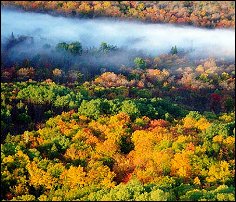 The Maple Family has only 2 genera, and most of the 117 (or so) species
of trees and shrubs are in the genus Acer. Members are
located around the world largely in the northern hemisphere, most in the temperate climates.
The greatest concentration of species is along the eastern Himalayas and into
China. In the U.P. there are a number of maple species, but only four
commonly reach tree size. U.P. maples usually have palmate,
simple leaves. Boxelder,
the exception, has compound leaves.
All four species have samara
fruits commonly referred to as "helicopters". All but the sugar
maple seed in the spring. All maples are oppositely-branched,
a characteristic in U.P. trees shared only with ashes.
The Maple Family has only 2 genera, and most of the 117 (or so) species
of trees and shrubs are in the genus Acer. Members are
located around the world largely in the northern hemisphere, most in the temperate climates.
The greatest concentration of species is along the eastern Himalayas and into
China. In the U.P. there are a number of maple species, but only four
commonly reach tree size. U.P. maples usually have palmate,
simple leaves. Boxelder,
the exception, has compound leaves.
All four species have samara
fruits commonly referred to as "helicopters". All but the sugar
maple seed in the spring. All maples are oppositely-branched,
a characteristic in U.P. trees shared only with ashes.
 SUGAR MAPLE
(Acer saccharum)
SUGAR MAPLE
(Acer saccharum)
Other
Names: Hard Maple, Rock Maple
Key ID Features: Leaves, Fruit, Buds, Bark
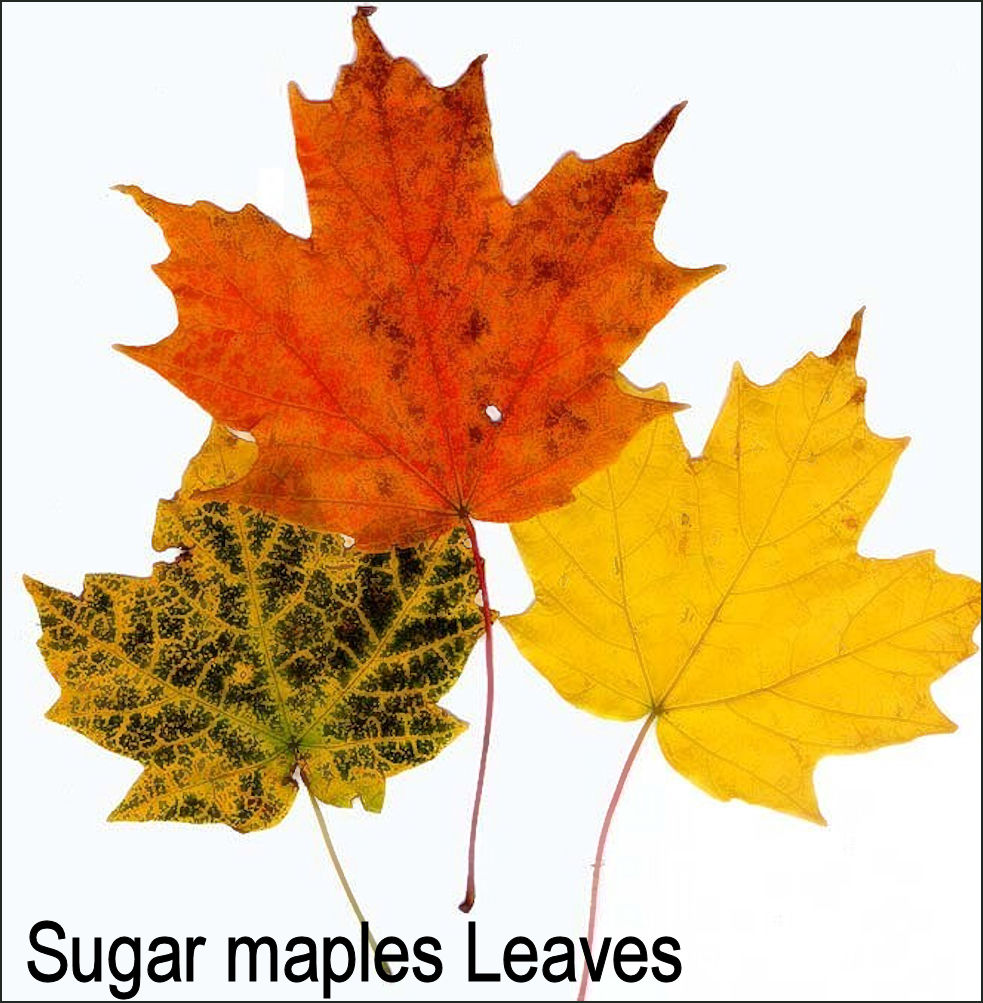


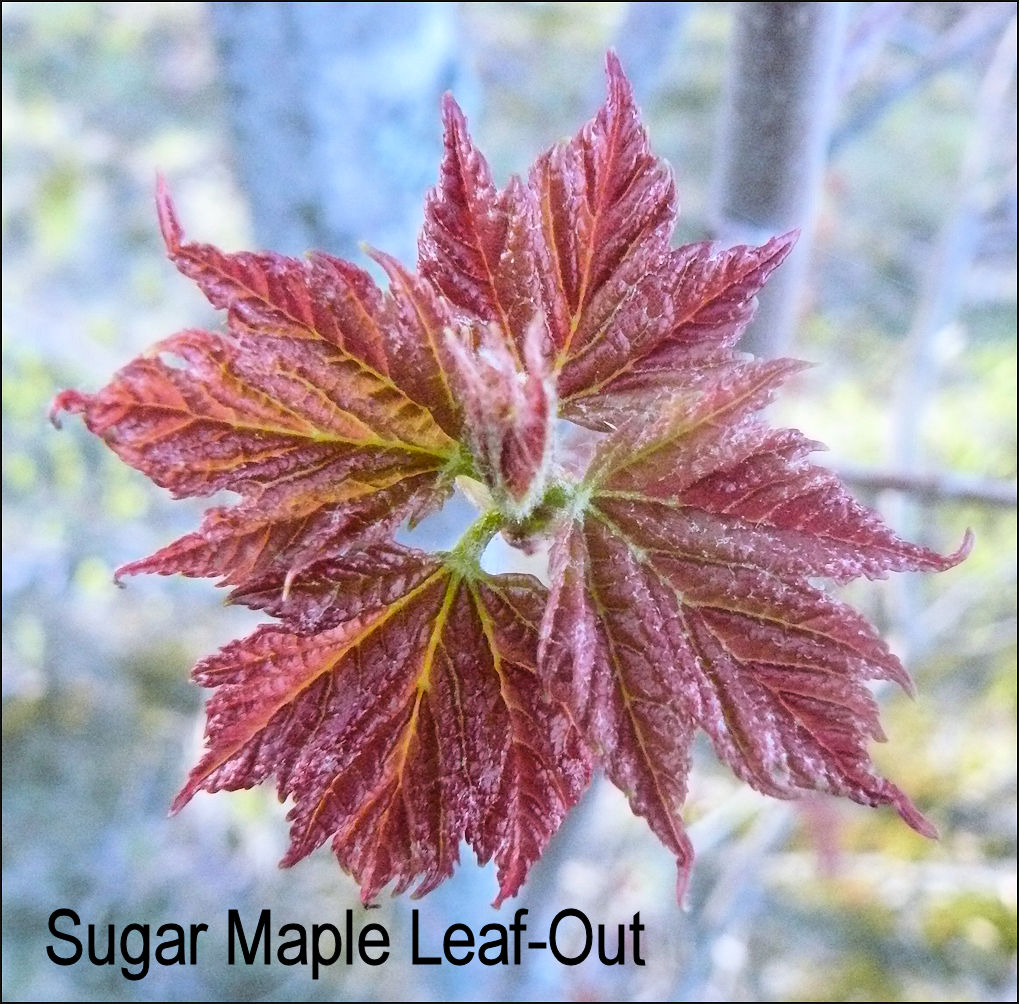
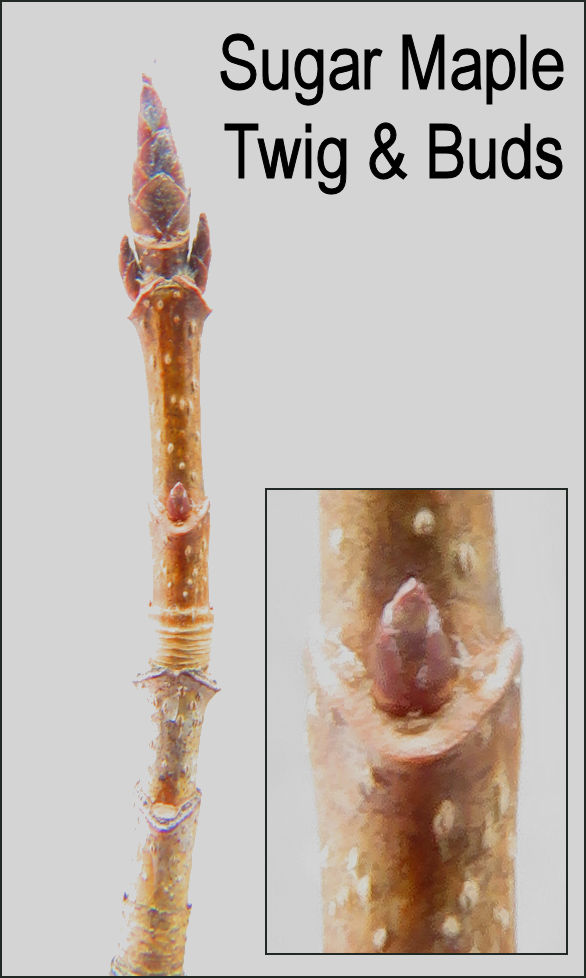

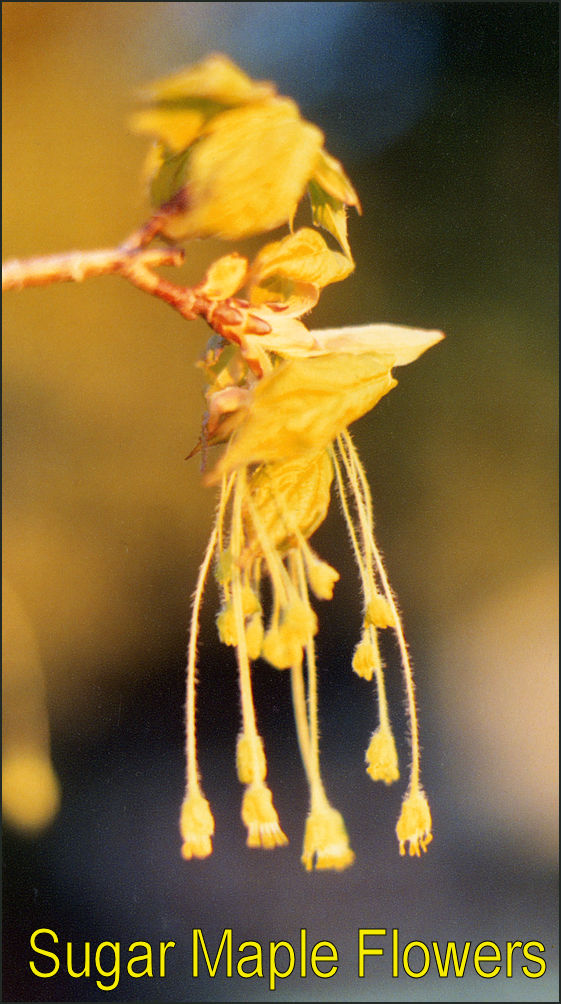
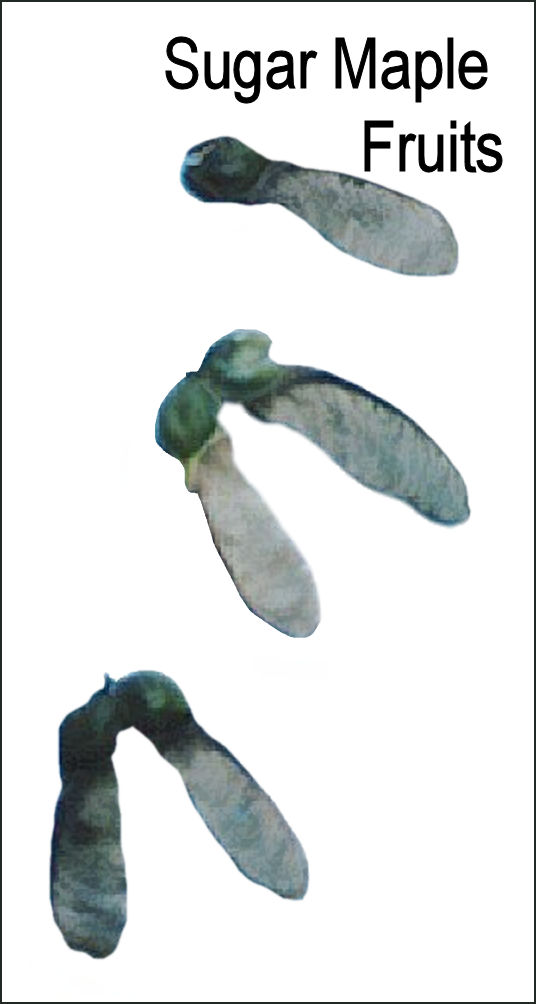
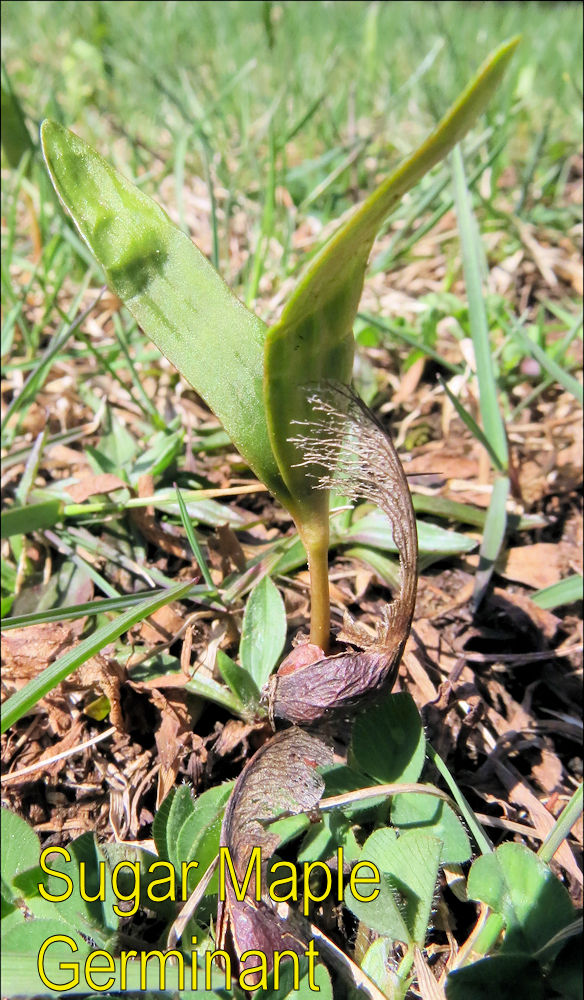


Sugar maple is the most common
tree in the U.P., probably the most favorable growing area in the United States.
It's palmate, 5-pointed LEAF with
smooth margins is featured on the
Canadian flag. The two-winged, two-seeded, U-shaped "helicopters" are
about 1 inch long. Sugar maple is the only native maple to seed in late summer and
fall. The TWIGS are slender, shiny, and medium brown with sharp terminal BUDS. The BARK varies quite a bit
as the tree ages. Young trees have smooth, medium-gray bark. Older trees form
platy bark that grows into rough, deeply fissured bark as the tree reaches larger
size. Some trees will show a sooty black residue that is a harmless fungus on the
bark surface. HEIGHTS reach over 80 feet with DIAMETERS 2-3 feet. The species
prefers moist, rich SOILS but will grow reasonably well in sandy loams. It is the
flagship species of our northern hardwood forest
type. Some common ASSOCIATES are basswood, beech, yellow birch, white
ash, hemlock, and white pine. It's ability to reproduce under fairly heavy shade
causes sugar maple to dominate northern hardwood stands to the point where it can form
monocultures. Common pests: forest tent caterpillar, leaf galls, leafminers, cankerworms, tussock moths, Asian longhorned beetle, sugar maple borer, maple petiole borer, sapstreak, Eutypella canker.
 RED MAPLE
(Acer rubrum)
RED MAPLE
(Acer rubrum)
Other
Names: Soft Maple, Swamp Maple, White Maple
Key ID Features: Leaves, Fruit, Buds, Bark
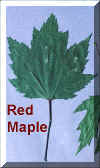
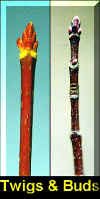
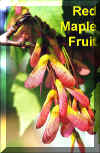
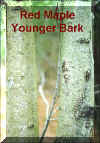
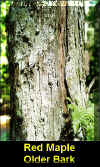
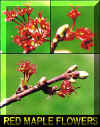

LEAVES are
generally 3-lobed with coarsely toothed-margins
and often whitish on the undersides. The sharply V-shaped "helicopters"
ripen in late spring or early summer. The youngest TWIGS are shiny and
reddish. Terminal BUDS are
reddish and round. Reddish FLOWER BUDS form clusters that can be easily confused
with leaf buds. These flower bud clusters can be easily seen from the ground, even
while looking at taller trees. The BARK on younger trees is smooth and medium-gray,
although somewhat darker that sugar maple. On older trees, the bark forms vertical
plates and begins to "peel" up over time. Red maple grows rapidly.
Tree HEIGHTS usually reach about 70 feet. DIAMETERS over 18 inches are uncommon,
although old trees on good sites can reach larger size. Red maple is often found on
swampier sites in association with elm, ash, and cottonwood but it can also be found on
drier upland sites in association with most hardwood types. It is one of the first
tree species to be found under older red pine stands. Common pests: forest tent caterpillar, leaf galls, leafminers, cankerworms, tussock moths, Asian longhorned beetle, Anthracnose, maple tar spot, Verticillium wilt, Eutypella canker, frost cracking. leaf scorch.
 SILVER MAPLE
(Acer saccharinum)
SILVER MAPLE
(Acer saccharinum)
Other
Names: Soft Maple, River Maple, Silverleaf Maple, Swamp Maple
Key ID Features: Leaves, Fruit, Buds, Bark, Habitat
A rather UNCOMMON maple in the U.P. It has followed human settlement up the larger Lake Michigan river systems and has been planted in many homesteads. The LEAVES are 5-lobed, coarsely-toothed, with deep sinuses. The undersides are very white or silvery which fades somewhat over the summer season. The "helicopters" are about 2 inches wide, with each half at about 90 degrees to each other. TWIGS are similar to red maple but a bit stinky when bruised. Terminal BUDS are a bit longer but still blunt. BUDS on young trees is silvery smooth but becomes very shaggy on older trees. Trees grow to about 70-80 feet and can reach DIAMETERS of 3 feet or larger. Silver maple is a fairly popular tree for ORNAMENTALS because of its rapid growth, silvery color, and excellent shade. However, the root systems seek out rich water sources, which often ends up being sewer lines and drain-fields. The tree has weak wood and is prone to ice and storm damage. Common pests: forest tent caterpillar, leaf galls, leafminers, cankerworms, tussock moths, Asian longhorned beetle, Anthracnose, maple tar spot, Verticillium wilt, Eutypella canker, frost cracking. leaf scorch.
 BOXELDER
(Acer negundo)
BOXELDER
(Acer negundo)
Other
Names: Ash-leaf Maple
Key ID Features: Leaves, Fruit, Buds, Bark
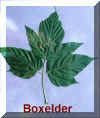
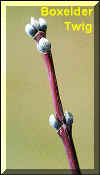
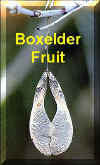
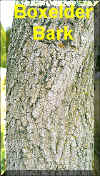
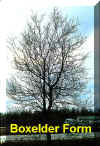

Boxelder is kind of the
"black sheep" of the maple family. It's compound LEAVES resemble ashes, usually
with five leaflets. The thickish, purplish or greenish TWIGS have a blue-powdery
look to them earlier in the season. BUDS are roundish. The
"helicopters" are V-shaped and about 1.5 inches long. Boxelder has male
and female trees. The females will often retain some of the helicopters into the
winter. The firm BARK is a warm brown and becomes ridged fairly early. The
TRUNK is often sweepy with large, low forks. The MEDIUM-SIZED tree is often
considered a weed, especially the female trees which can shed large amounts of seed in the
summer. In the fall, the tree is associated with infestations of boxelder
bugs. They are harmless but are not usually welcome when they invade
basements. Boxelder grows rapidly and makes an excellent climbing tree for
kids. Boxelder is an aggressive invader of fallow fields and roadside ditches.
OTHER TREE-SIZED MAPLES (Acer spp.)
Black Maple (Acer
nigrum)
Sometimes considered a race of sugar maple, black maple leaves are darker green and
shinier. Twigs tend to be a bit stouter and the seeds proportionately larger in the
helicopters. Not common in the U.P.
Norway Maple (Acer platanoides)
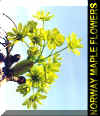
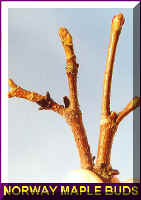
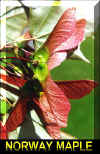
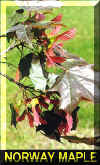
A native of central
Europe. Often used as an ornamental along city streets. Resembles sugar maple
but twigs are distinctly purple and terminal buds larger. Leaves also sometimes have
a purple color to them. Helicopters are a little smaller.
Click on the blue
to return to the Deciduous Summer Key or
Deciduous Winter Key.
Click HERE
to return to the home page.
A note about the images on this website, click here.
This site created and maintained by Bill Cook, MSU Extension Forester for the Upper Peninsula of Michigan. Editing and modification is ongoing. Submit suggestions, questions, and corrections to cookwi@msu.edu or call 906-786-1575.